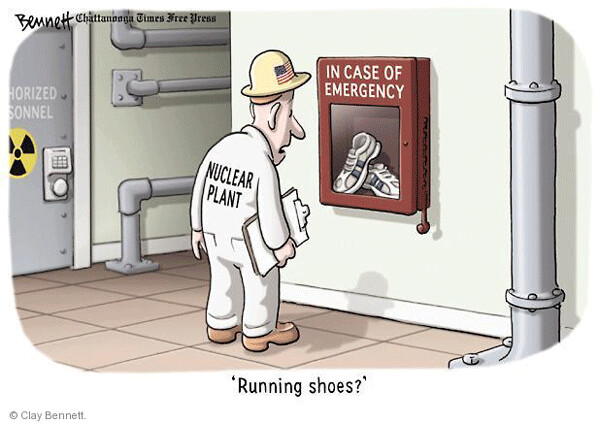News & Articles
Browse all content by date.

Marilyn Elie, of the Indian Point Safe Energy Coalition, reminds us that Stewart Brand (Whole Earth Catalog) and Amory Lovins of Rocky Mountain Institute have been friends for years. They talked about nuclear power and came to two different conclusions. When Brand came out in support of nuclear power (“Whole Earth Discipline,” Viking 2009), Lovins demolished his arguments [without even noting nuclear’s catastrophic disaster risks or the costs and risks of waste management] in a carefully reasoned article that touches on four main points that proponents continue to use. Dr. Lovins’s points are concise and irrefutable. Brand’s myths are still pushed by Jim Hansen, the Nuclear Energy Institute and other nuclear power advocates in spite of the fact that they have been thoroughly refuted.
The four arguments proponents continue to use are:
1) Baseload: Wind and photovoltaics can’t keep the lights on because they can’t run 24/7;
2) Footprint: Photovoltaics need about 150-175 times, and wind farms from 600+ to nearly 900 times more acreage than nuclear reactors to produce the same amount of electricity;
3) Portfolio: We need every tool for combating climate change, including nuclear power; and
4) Government role: The climate imperative trumps economics, so governments everywhere must and will do what France did — ensure that nuclear power gets built, regardless of economics or dissent.
These claims are unsupportable as Lovins explains below. Lovins’s last point — nuclear power is being pushed in countries with “socially planned energy systems,” while renewables are thriving in democracies and free markets — is especially relevant today. Lovins explains:
Baseload: The electricity system doesn’t rely on any plant’s ability to run continuously; rather, all plants together supply the grid, and the grid serves all loads. That’s necessary because no kind of power plant can run all the time, as Stewart says they must do to meet steady loads. I repeat: there is not and has never been a need for any particular plant, or kind of plant, to run all the time, and none can do so. All power plants fail, varying only in their failures’ size, duration, frequency, predictability, and cause. Solar cells’ and wind power’s variation with night and weather is no different from the intermittence of coal and nuclear plants, except that they affect less capacity at once, and more briefly, far more predictably, and are no harder and probably easier and cheaper to manage. In short, the ability to serve steady loads is a statistical attribute of all plants on the grid, not an operational requirement for one plant. Variability (predictable failure) and intermittence (unpredictable failure) must be managed by diversifying type and location, forecasting, and integrating with other resources. Utilities do this every day, balancing diverse resources to meet fluctuating demand and to offset outages. Even with a largely (or probably a wholly) renewable grid, this is not a significant problem or cost, either in theory or in practice — as illustrated by areas that are already 30-40% wind-powered.
Footprint: Stewart understates nuclear power’s land-use by about 43-fold by omitting all land used by exclusion zones and the nuclear fuel chain. Conversely, he includes the space between wind and solar equipment — unused land commonly used for farming, grazing, wildlife, and recreation. That’s like claiming that two lampposts require a parking lot’s worth of space, even though 99% of the lot is used for parking, driving, and walking. Properly measured, per-kilowatt-hour produced, the land made unavailable for other uses is about the same for ground-mounted photovoltaics as for nuclear power, sometimes less — or zero, for building-mounted PVs sufficient to power the world many times over. Land actually used-per-kWh is up to thousands of times smaller for wind power than for nuclear power. If land-use were an important criterion for picking energy systems, which it’s generally not, it would thus reverse Stewart’s footprint conclusion.
Portfolio: The one paper he cites as proof that we need all energy options (Pacala & Socolow’s “Stabilization Wedges”) actually says the opposite. There is no analytic basis for his conclusion, and there’s strong science to the contrary. We can’t afford to stuff our energy portfolio indiscriminately with some of everything, and we shouldn’t: some options are less worthy and effective than others. The more you fear climate change, the more judiciously you should invest to get the most solution per-dollar and per-year. Nuclear flunks both these tests.
Government: If nuclear power isn’t needed, worsens climate change (vs. more effective solutions) and energy security, and can’t compete in the marketplace despite uniquely big subsidies — all evidence-based findings unexamined in Stewart Brand’s chapter — then his nuclear imperative evaporates. Of course, a few countries with centrally planned energy systems, mostly with socialized costs, are building reactors: over two-thirds of all nuclear plants under construction are in China, Russia, India, or South Korea. But that’s more because their nuclear bureaucracies dominate national energy policy and face little or no competition in technologies, business models, and ideas. Nuclear power requires such a system. The competitors beating nuclear power thrive in democracies and free markets.
The original article appeared in Grist. See: www.grist.org/article/2009-10-13-stewart-brands-nuclear-enthusiasm-falls-short-on-facts-and-logic.
| Tweet |

